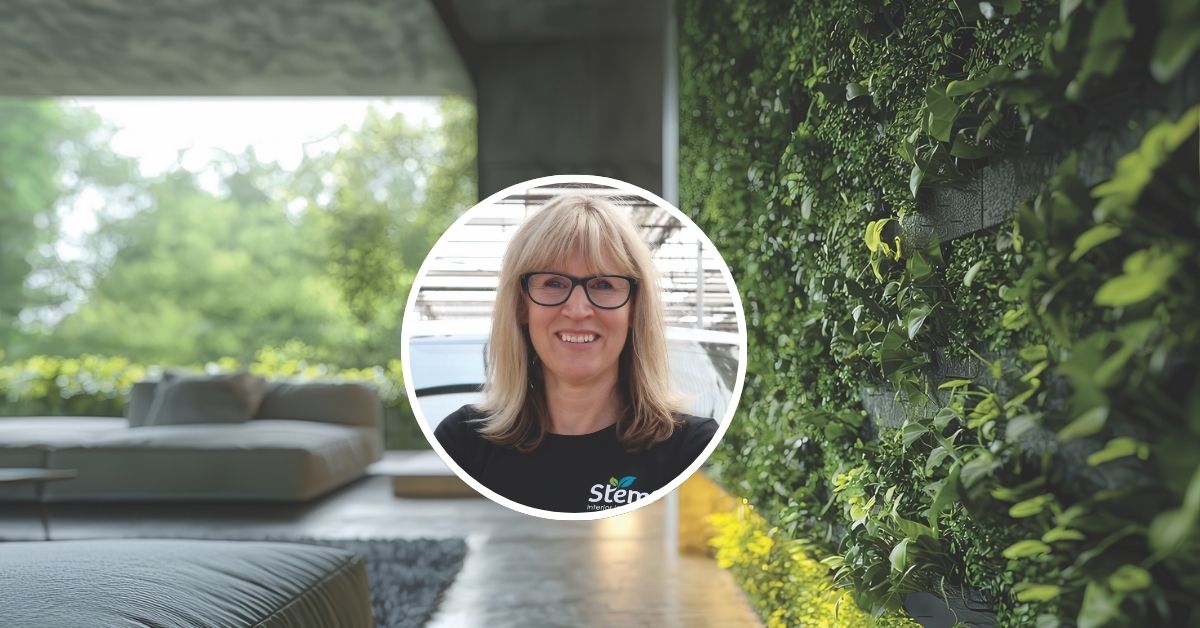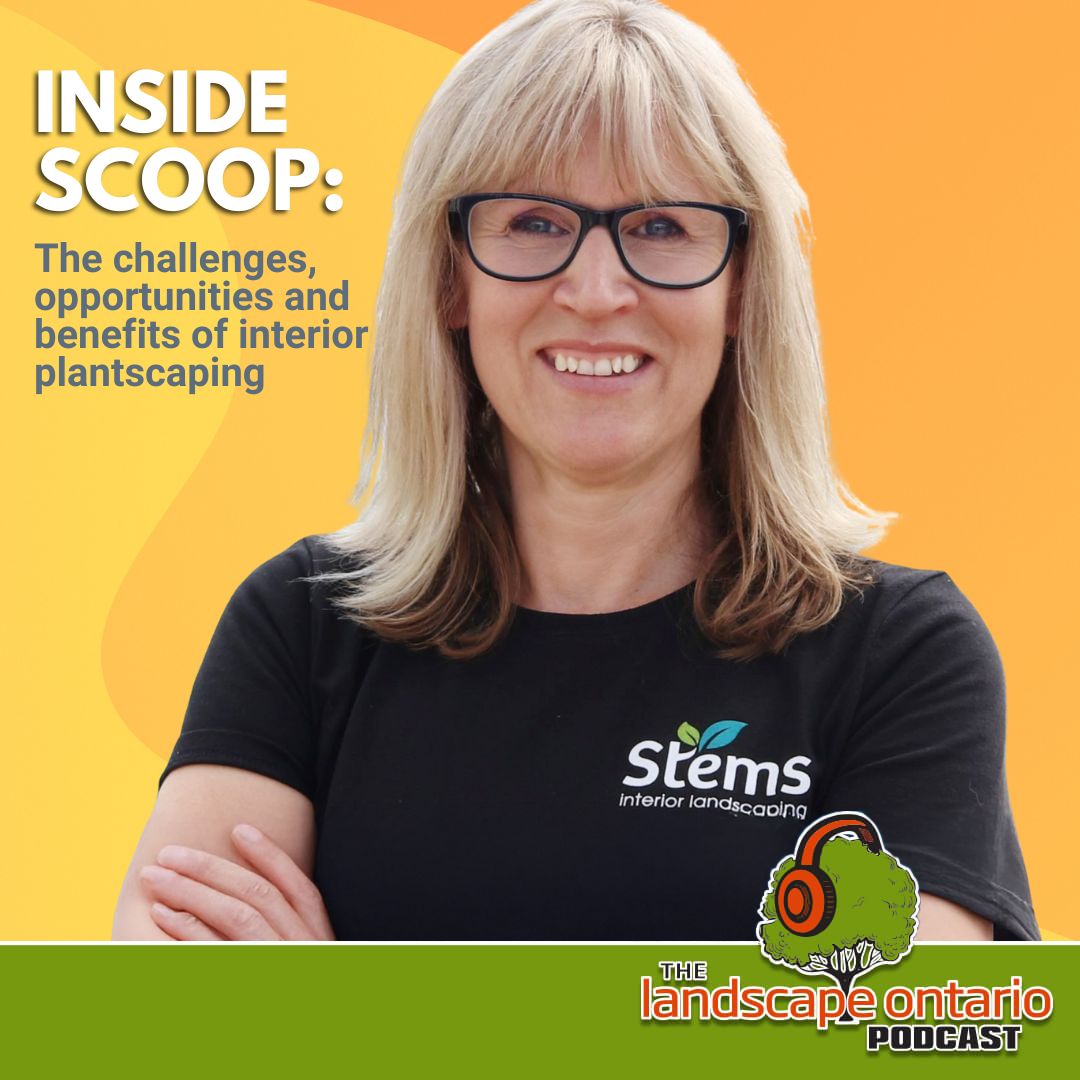
The challenges, opportunities and benefits of interior landscaping
Interview with Hella Keppo, CHT
By Karina Sinclair
Interior plantscaping is a niche within the green industry that combines horticulture, design and wellness to create indoor environments that inspire and rejuvenate. While the thought of landscaping often brings to mind outdoor gardens, the transformation of interior spaces with plants is equally impactful. This excerpt from the Landscape Ontario podcast (January 2025), highlights a conversation with Hella Keppo, founder of Stems Interior Landscaping in Toronto, Ont. Keppo turned her passion for plants into a career that not only beautifies indoor environments but also delivers real benefits — cleaner air, reduced stress and enhanced creativity, to name just a few. From moss art and blooming displays to impressive living walls, Keppo and her team are transforming spaces and changing how people experience their work environments.
Explain what it is like to have an interior plantscaping business.
Hella Keppo: The main thing we do is install and maintain indoor office plants. It all starts with putting the right plant in the right spot, which sounds simple, but it takes a lot of years of trial and error — seeing what works and what doesn’t in certain circumstances.
For most of our clients, we’ll do an initial walkthrough with their floor plan in hand and figure out which plants to put where. Then we go back, do a proposal, send it off and once it’s approved, the real work begins. We deliver all the plants. It’s funny because when we deliver them, people will literally come out of their offices and ask, “Do I get one in my office too?” People just get so excited when this cart of plants rolls by their door.
What are some of the unique challenges of interior landscaping?
One of the big complications, especially when designers or a client has existing containers, is we cannot have those containers leak. A lot of the cheaper big ceramic pots have a drainage hole in them. You just can't water a plant and have a hole in the bottom in the indoor environment because that water is just going to pour through. Then you have a risk of mold growing under the container, like if it's on carpet, or even slips and falls if there's a puddle on a hardwood floor. Our containers are completely watertight, so that's one of the big challenges.
Some of the other ones are pests. A lot of the plants will get spider mites, mealybugs, scale, fungus gnats and all of those we're able to deal with and make sure that everything is clean. We can't spray anything because it's indoors. We're not allowed to use pesticides or anything. So most of the treatment for pests is just physically wiping them off the leaf. Sometimes we can spray with soapy water, literally a drop of dish soap in a sprayer, and clean the leaf off. That’s the best way we can control insects.
I do use some IPM (integrated pest management). If it's a larger atrium area or a solarium, then we can release some biological insects that are tiny. They're as small as the plant bugs, and the regular person wouldn't even know there's a bug there at all. So sometimes we can use that.
How did COVID-19 lockdowns affect your ability to operate in office buildings?
Getting into the offices was a huge challenge. As the world knows, we were locked out for at least four weeks. Before the lockouts began, it was all hands on deck. I told my staff to just flood everything. We need them to get through these next two to three weeks. And so we did that.
Luckily, Landscape Ontario was a huge benefit, rallying the government to try and get landscapers deemed essential. A couple of our clients were hospitals, and they basically said, “get back over here.” So I got that in writing, and we were able to start doing our work again.
Then, of course, the next challenge was actually gaining access to the offices. Many clients were great. Most of them had security, and the ones that didn’t would meet us to let us in or gave us fobs. We have a lot of trust with our clients, and they did allow us to get access again.
What’s it like working with clients who now have a hybrid workspace model?
That's a challenge. Monday and Friday are skeleton staff. I think that's pretty typical. Wednesdays seem to be the day that all the meetings occur.
Getting into meeting rooms and boardrooms has become a challenge. When that happens, we’ll first try to get into meeting rooms that we know are always busy, especially if there are obviously plants in there. If we can't get in, then we'll do our other work at that office, check in again, and if we still can't get into water, we sometimes ask the receptionist if she can throw some water on there. Otherwise, sometimes, depending on if that plant requires more water, we'll make a special trip back.
How do you care for plants year round, including those that may be in vulnerable locations?
Yes, we're year-round in the indoor environment. You think it doesn't change much, but it really does. As soon as fall comes and the temperatures outside start to go down, the heaters come on in the buildings. That just dries the plants out so quickly. It's pretty shocking sometimes. The air in the office starts to get really dry as well. Obviously, in the winter, it gets very dry. February is bad for that, but at least then it's lower light as well, so it starts to balance off a little bit.
In the spring, when the air conditioners come on, it's the opposite. We get cold breezes, and the plants don't dry out as quickly. Although then, with the longer days and more sunshine, it starts to work itself out again.
What sorts of issues might a plant experience when being displayed in an atrium or near a building entrance?
In the winter, it's terrible. Especially at these big entrances to big buildings and lobbies with automatic doors. I have had plants freeze solid. Well, maybe not quite solid, but they definitely turned black from the freezing cold air hitting them. It does not take long. Tropical plants are as perishable as a head of lettuce. If you freeze it and then thaw it, it just goes to mush.
How does biophilic design fit into your business model?
Biophilia literally translates into love of life. It’s the innate, biologically driven need to interact with other forms of life, such as animals and plants. The mission of Stems, my company, is to connect people to nature with lush, thriving tropical plants. And that’s really important because we need to be connected to nature. I mean, that’s what biophilia is all about, connecting with nature.
The problem is that we spend 80 to 90 per cent of our time inside. So how do you connect to nature? We’re Canadians. We love nature. We love going outside and experiencing it — canoe trips, hiking and everything. But how often can you do that? We have winter here. That’s why I figured it’s best to connect with nature where we spend our time, and that’s by bringing plants indoors.
What do you think are some of the most important skills needed for somebody who wants to run a business focused on interior landscaping?
The first thing you need is a passion for plants. The second thing is you need to love people because it’s not like an outdoor landscape job where you’re outside not even seeing the homeowner or business owners. We’re inside their office, inside their buildings. And we need to be approachable and, yet, also very quiet and get our work done without too much chitchat. We like to be efficient.
 This interview was adapted from an episode of the Landscape Ontario podcast, published on Jan. 2, 2025. To hear the whole interview, visit landscapeontario.com/podcast, or search for it on your favourite podcast app.
This interview was adapted from an episode of the Landscape Ontario podcast, published on Jan. 2, 2025. To hear the whole interview, visit landscapeontario.com/podcast, or search for it on your favourite podcast app.